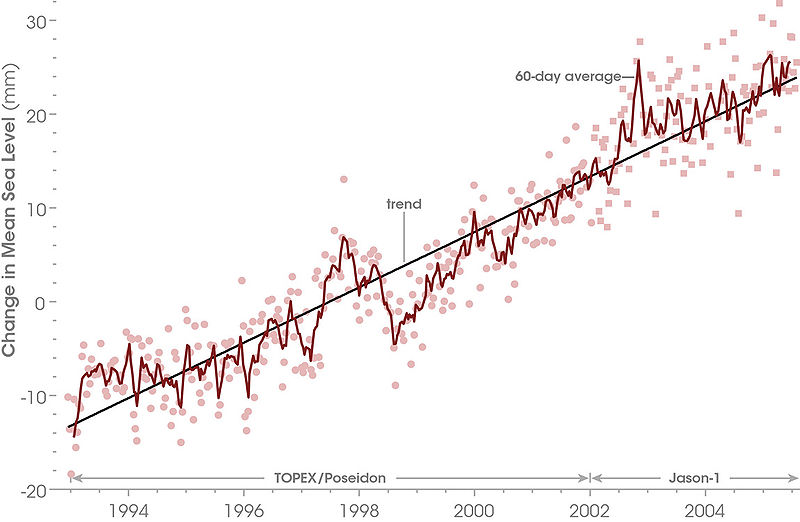Sea level rise at the present timeOne could hope that we could just measure the sea level and see how it is changing. But we are talking about a change on the order of 2 mm per year. Obviously you can't just go down to the local pier and measure that; it will be swamped, for example, in the daily tides. Besides, there are a lot of factors influencing sea level over short time scales: not only daily tides, but lunar tide cycles, and cycles of length 14 months and 18.2 years with astronomical origins. See the Wikipedia article on sea level rise for more details. Since land masses also change in elevation, even if we averaged many high-tide readings at the same location, we would still be measuring only the sea level relative to that land mass. A better method is to use satellites to measure the sea level relative to the Earth's center of mass. This is also a complicated business; but here is what NASA says is the result: 3.1 mm per year at present:
You can read what NASA has to say about these satellite measurements at this NASA page and by following links from there. Curiously, this 3.1 mm/yr number is higher than the numbers (more like 2.1 mm/yr) derived from land measurements, but obviously both methods don't have pinpoint accuracy. For example, the satellite uses radar to measure its height above the ocean, but its own position may not be known exactly due to orbital decay, so it is constantly recalibrated using measurements of its distance from land stations whose height above mean sea level is presumed known by surveying. At 3 mm/year, by 2100 the sea level would rise 30 cm. That is in the mid-range of the IPCC's six scenarios in their 2007 Assessment Report; the six scenarios range from 19 to 58 mm by 2100. Causes of changes in sea levelThere are two factors changing sea level: Over geological time periods, changes in the size and shape of ocean basins can also affect sea level, but nobody expects such changes by 2100. Note the phrase net melting: enough snow falls on the Greenland ice pack to lower sea level 8 mm/yr, but also, the ice melts constantly, so these effects almost balance out, and it will be difficult to establish which one is greater, since both are an order of magnitude greater than the difference. These issues are properly considered as issues of ice, rather than issues of sea level. |
Michael Beeson's Home Page
-->
